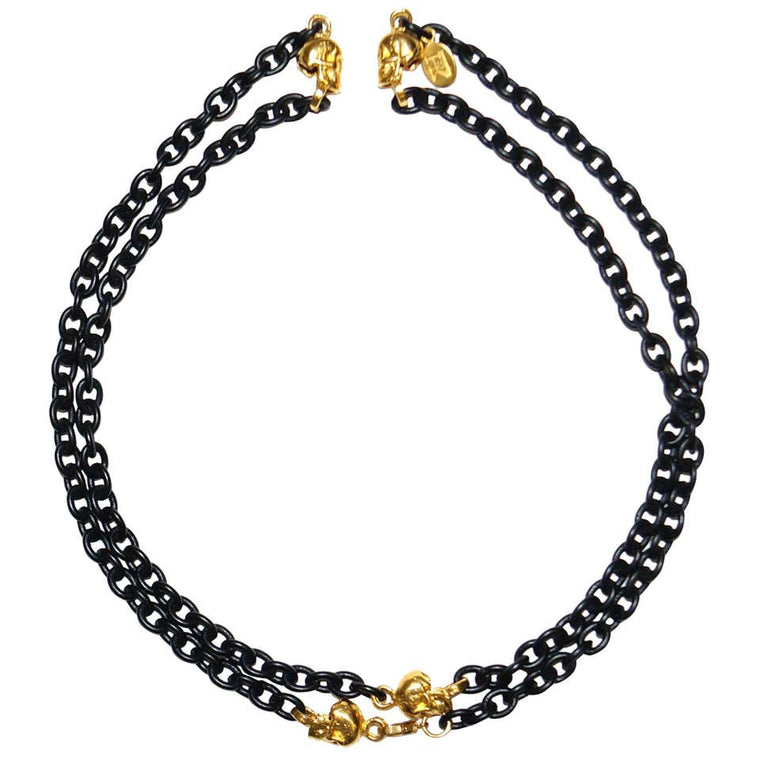Description
Astounding vivid blue, green, and orange enamel and beaded necklace by Hattie Carnegie! This Egyptian Revival piece features an enamel lotus flower necklace with seven tassel - like strands of faux turquoise and lapiz lazuli beads dangling from the bottom curve of the medallion. The pendant is suspended on a book chain ornamented with the occasional faux lapiz bead. An amazing piece for those who love history and drama!Hattie Carnegie was born Henrietta Kanengeiser in Vienna, Austria-Hungary. She was the second of seven children, and lived in poverty in her youth. The family immigrated to the United States when she was still a child, and settled in Manhattan. After her father’s death in 1902, Hattie took a job as a messenger at Macy’s to help support her family, and in 1904 she modeled and trimmed hats at a millinery.
In 1909 Hattie branched out, launching a hat making business with dressmaker Rose Roth, but by 1919 Roth had left the business, leaving Carnegie as the owner of “Hattie Carnegie, Inc,” a company that had a working capital of $100,000. Carnegie began traveling to Paris to buy original dresses to both sell in her shop, and use as inspiration for her own garment and accessory designs. Carnegie was instrumental in bringing Paris fashion to the United States; she imported Lanvin, Molyneux, Patou, Schiaparelli, Vionnet, and others, lavishing New York with gorgeous garments and groundbreaking designers that would have not crossed the pond otherwise. Carnegie also discovered and nurtured the talents of many prominent American designers, including Norman Norell, Pauline Trigère, and James Galanos. In 1925, Carnegie bought a building off of Park Avenue to house her $3.5-million-a-year business, and stayed there producing pieces throughout the Great Depression.
During World War II French haute couture came to a standstill. Carnegie rose to prominence on the international stage as an authority on fashion, and her works were seen in the theatre, cinema and on magazine covers. Although still glamorous, her designs became more austere when the United States joined the Allied Powers. As a part of the war effort, Carnegie designed a dress for Life Magazine. The dress patterns were published in the magazine alongside detailed instructions; it was said that although the dress could have been made for as little as $5, the original dress was valued at $175. After the war, Carnegie continued her business, the epitome of perseverance.
Sometime in her early 20s, Hattie had taken the last name Carnegie after Andrew Carnegie, the industrialist, philanthropist, and richest man in the United States during her lifetime. She certainly lived up to the name, having worked her way through and out of an impoverished childhood and into a glamorous life doing what she loved, while still grossing millions a year. Carnegie passed away in 1956, having been instrumental in the diffusion of Parisian fashion into American society, having nurtured the finest designing minds of the early and mid 20th century, and having designed all manner of enchanting things, including hats, handbags, gloves, jewelry, furs, lingerie, cosmetics, and even perfume.
-
Country of OriginUnited States
-
ConditionExcellent
-
Materials & TechniquesEgyptian Revival Enamel
-
SizeTotal Length
22.5 Inches
Related Items
Knight & Hammer Gold Tone Skull and Black Matt Enamel Chain Necklace
$455.00
Dramatic and macabre skull necklace by Knight & Hammer. We adore this bold opera length necklace, with black enamel chain accented by four brilliant, polished gold skulls. Wear to the opera (and scandalize!) or over that perfect white tee with jeans (and scandalize!). A truly flexible necklace!
We're really feeling an Alexander McQueen / Damian Hirst "For the Love of God" rhinestone skull vibe from this piece.
LENGTH
40 in. (1016 mm)
WEIGHT
96 g
1970s Pauline Trigere Black & Silver Burnout Velvet Evening Dress Ensemble
$800.00
Simply astounding evening dress ensemble by Pauline Trigere. The ensemble consists of a dramatic skirt and matching cardigan. The skirt is maxi length with an A - line silhouette and narrow waistband. The cardigan is hip length, with long sleeves and an open front. The ensemble is fabulous, with sheer black base and scalloped devore burnout velvet that shimmers beautifully. Wear with a black silk romper (or our listed silver lame Pauline Trigere romper!) topped with the cardigan tucked wrap - like into the skirt for some 70s studio 54 fabulousness!
Skirt Measurements
Waist: 30"
Hip: 32"
Length: 42.5
Jacket Measurements:
Bust: 34"
Length: 26"
1960s Adele Simpson Blue, Yellow, and White Quilted Floral Dress
Sold Out


